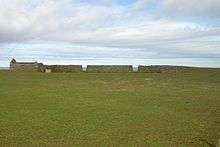1st Caithness Artillery Volunteers
The Caithness Artillery Volunteers were formed in 1860 as a response to a French invasion threat. They served as a Coast Artillery unit and continued in existence until being disbanded on the formation of the Territorial Force in 1908.
| 1st Caithness Artillery Volunteers | |
|---|---|
| Active | 1859–1908 |
| Country | |
| Branch | |
| Type | Artillery Regiment |
| Role | Garrison Artillery Coastal Artillery |
| Garrison/HQ | Wick Thurso (from 1882) |
| Commanders | |
| Honorary Colonel | Sir John Rose George Sinclair, Bart., DSO, VD (hon. captain in the army), 7 November 1900. |
History 1859-1908
In 1863, the 1st, 2nd, and 3rd Caithness, 1st, 2nd, 3rd, and 4th Orkney, and 1st Ross Artillery Volunteer Corps were formed into the 1st Administrative Brigade Caithness Artillery Volunteers, with headquarters at Wick.[1]
The Caithness corps, which then, or on their subsequent formation, formed part of the brigade were —
- 1st Corps formed at Wick, Caithness on 6 March 1860 as one battery. Increased to one and a half batteries in 1867, and to two batteries in 1870
- 2nd Corps formed at Thurso on 24 April 1860, as one subdivision. Increased to one battery on 28 December 1860, and to two batteries in 1870
- 3rd Corps formed at Lybster on 30 September 1861, as one battery; disbanded 1873
- 4th Corps formed at Barrogill, Mey on 1 December 1866, as one battery
- 5th Corps formed at Castletown on 1 December 1866, as one battery
- 6th Corps formed at Thrumster on 4 May 1867, as one battery. Disbanded 1878

The first uniform of the Caithness corps was similar to that of the Royal Artillery, but with scarlet cuffs and white cord and piping. Busbies and white belts were worn. The officers had silver lace, and their tunics were piped all round with silver cord, and had silver lace on the skirts.
In 1867, the Orkney and Ross Artillery Volunteer Corps were withdrawn from the brigade, and to it were added the 1st Sutherland Artillery Volunteers, based at Helmsdale, originally formed 26 April 1860, which had since 1863 been attached to the 1st Inverness Artillery Volunteers. Its uniform was similar to that of the Caithness corps, but the busbies had chin-chains.
The 2nd Sutherland Artillery Volunteers at Golspie, formed 18 February 1867. This was a body of fishermen of wonderful physique; at its first parade, the two flank men were each 6 ft. 6 in. The uniform was the same as the 1st Sutherland.
In 1880, the brigade was consolidated as the 1st Caithness Artillery Volunteers with headquarters at Wick. By this time, there were eight batteries:[2]
- Nos. 1 and 2, Wick (late 1st Caithness)
- Nos. 3 and 4, Thurso (late 2nd Caithness)
- No. 5, Mey (late 4th Caithness)
- No. 6, Castletown (late 5th Caithness)
- No. 7, Helmsdale (late 1st Sutherland)
- No. 8, Golspie (late 2nd Sutherland)
In 1882, headquarters were transferred from Wick to Thurso. In 1894, the 1st and 2nd Companies ceased to exist, but in 1897 the 1st was resuscitated, with the corps consisting of seven garrison companies, the 2nd being vacant.
The corps had a drill battery at each station, and possessed six firing ranges for carbine practice.
In 1902, the unit was retitled the 1st Caithness Royal Garrison Artillery (Volunteers).[3] On the formation of the Territorial Force in 1908, the unit was no longer required and was disbanded.
Commanding officers
The lieutenant-colonels to have commanded the unit were:[4]
- Sir Robert S. Sinclair, Bart, of Murkle, 10 October 1864
- G P A Earl of Caithness, 17 June 1882
- George E. Lawson (hon. col.), 25 May 1889
- Sir John R G. Sinclair, Bart, DSO, of Dunbeath, 2 July 1892
- Alexander M'Donald VD (hon. col.), 9 May 1900
- David Keith Murray VD (hon. col.), 5 April 1905
See also
- 1st Berwickshire Artillery Volunteers
- 1st Midlothian Artillery Volunteers
Notes
- Lt Gen Sir James Moncrieff Grierson, Records of the Scottish Volunteer Force 1859–1908, William Blackwood & Sons Ltd, 1909, p152
- Litchfield, Norman E H, and Westlake, R, 1982. The Volunteer Artillery 1859-1908, The Sherwood Press, Nottingham, p35
- Army List, His Majesty's Stationery Office, 1902
- Lt Gen Sir James Moncrieff Grierson, Records of the Scottish Volunteer Force 1859–1908, William Blackwood & Sons Ltd, 1909, p153
References
- Ian F.W. Beckett, Riflemen Form: A Study of the Rifle Volunteer Movement 1859–1908, Aldershot, The Ogilby Trusts, 1982, ISBN 0-85936-271-X.
- Lt Gen Sir James Moncrieff Grierson, Records of the Scottish Volunteer Force 1859–1908, William Blackwood & Sons Ltd, 1909.
- Litchfield, Norman E H, and Westlake, R, 1982. The Volunteer Artillery 1859-1908, The Sherwood Press, Nottingham. ISBN 0-9508205-0-4